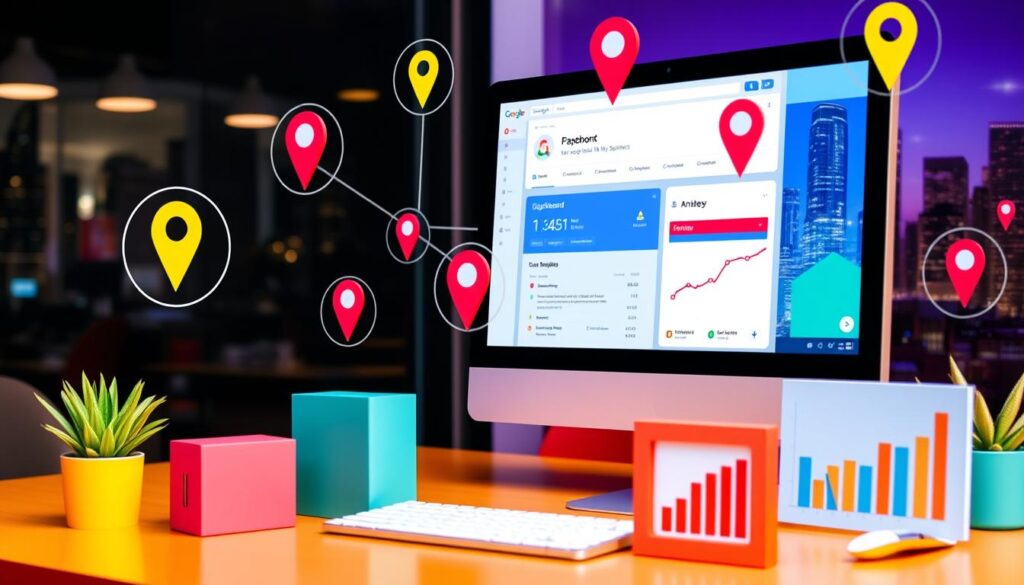In today’s world, having a strong online presence is key for business success. Local businesses need to use search engines to stand out. To optimize local SEO performance, it’s crucial to use strategies made for small businesses. This focuses on SEO for small businesses. Following the top local SEO best practices is essential for businesses wanting to improve their improving local SEO visibility.
Being visible online is more than just basic SEO. It includes understanding local needs and using specific tactics. These help connect your business to local searches. A good local SEO strategy makes your business stand out on Google. This is important when people nearby are looking for your services or products.
What separates growing businesses from those that don’t is how they show up online. Having a detailed Google Business Profile is foundational. It should include accurate location words, strong references, and a solid review system. This can push your business to the top of Google’s local search results.
Key Takeaways:
- Local SEO greatly increases a business’s visibility for searches in their area.
- Starting with a well-set-up Google Business Profile is key for local SEO.
- Using local keywords to check your performance helps with planning.
- Local schemas improve how well search engines understand your content.
- Core Web Vitals judge user experience, affecting local search positions.
- Interacting with reviews and keeping business info up-to-date boosts local search visibility.
Understanding Local SEO and Its Importance
Local SEO boosts a company’s visibility online for area-specific searches. It connects businesses with their target customers directly. This enhances their online presence locally and increases in-person visits.
Definition of Local SEO
Local SEO makes a business stand out in local searches. It involves optimizing Google My Business, creating local content, and accurate listings. These steps are key to appearing higher in local search results.
Key Differences Between Local and Traditional SEO
Traditional SEO aims to get global or national visibility. On the other hand, local SEO focuses on a specific area. It uses local search ranking factors like proximity, relevance, and prominence. These factors matter most to local businesses.
Benefits of Optimizing for Local Searches
Local SEO increases visibility among local buyers ready to buy. With Google My Business optimization and more, companies improve their local search rankings. This drives more web traffic and boosts sales.
| Local SEO Focus | Benefits |
|---|---|
| Google My Business Listings | Direct enhancements in local visibility and customer engagement |
| Local Citations Consistency | Builds trust and reliability in business information across the web |
| Relevant Local Content | Attracts localized traffic and boosts search engine rankings |
| User Reviews and Ratings | Improves credibility and encourages more customers to engage |
Google My Business: Your Local SEO Foundation
Local SEO strongly depends on how well you optimize your Google My Business. A well-kept profile boosts your online visibility. It also makes it easier for local customers to find you. We’ll explore how to use Google My Business to strengthen your local SEO.
Setting Up Your Google My Business Profile
Start by creating a Google My Business account. Claim your business listing and confirm you’re the owner. This ensures your business info is right and up-to-date. It’s key to being found online. Then, use local keywords to connect better with local shoppers.
Importance of Accurate NAP Information
Keeping your Name, Address, and Phone number (NAP) the same everywhere online is important. Mistakes can confuse customers and hurt your local search rank. So, check your details often. Being precise helps people trust your business more. This could lead to more visits to your website.
Leveraging Google My Business Features
Google My Business has many features to interact with users and get more engagement. Keep your profile updated and reply to reviews. Post about events or specials often. Good photos and a catchy description can draw more people. Use every feature to improve your local SEO.

It’s also key to track how well your Google My Business is doing. Use the insights to see how people interact with your profile. This info can help you make your profile even better. Stay on top of these metrics to keep up with local competition.
Following these tips can really help your business stand out online. Keep your profile interesting, right, and optimized. This way, you’ll draw in and keep your local customers interested.
Keyword Research for Local SEO Success
Understanding local keyword research is key to improving your online presence. It involves finding the search terms used by local consumers. By doing this, you can make your site, content, and listings rank higher in local searches. This boosts your visibility and chances for more business.
Identifying Local Keywords
Success in local searches starts with knowing your seed keywords, especially location-specific ones. For example, a local hair salon aiming to be more visible might use broad terms like “hairdresser,” “haircut,” and “hairstylist.” They add their city or locale to catch local searches such as “best hairdresser in Albany.” Kody Smith shows how effective this can be. He boosted his income by using local SEO and smart keyword choices, without paying for ads.
Tools for Effective Keyword Research
There are many SEO tools that help find good local keywords. The Google Keyword Planner is great for searching keywords by location. It’s a big help for SEO audits for local companies. Tools like SEMrush and Ahrefs also offer insights into how hard a keyword is and its search volume. These help businesses choose the best keywords for their local SEO. You can learn more about analyzing your competition to improve your SEO even more.
Long-Tail vs. Short-Tail Keywords in Local SEO
Choosing between long-tail and short-tail keywords affects your local SEO success. Long-tail keywords like “best organic grocery stores in Miami” are specific and target a niche. This leads to less competition and more conversions, fitting user searches better. Take Milano Bakery. They ranked #1 for “joliet bakery” and got a lot of targeted online traffic. Their story shows the power of a smart keyword strategy in local keyword research.
Using the right tools and strategies can lift your online presence. Aim for targeted local keyword strategies. It’ll bring more people to your place and boost your income. And the best part? You don’t have to spend much on ads.
Building Local Citations and Backlinks
Today’s digital world requires smart strategies for better online visibility. A key part of local SEO is building local citations and securing good backlinks. These efforts not only boost your search rankings but also build trust in your community.
What Are Local Citations?
Local citations refer to online mentions of your business’s name, address, and phone number. They help prove your business is real. Citations come in two types: structured, like on Google My Business, and unstructured, like in blogs. Properly managed local citations can lift your local search ranking by up to 22%.
Strategies for Earning Quality Backlinks

Earning backlinks from reputable local sources boosts your SEO. This includes links from newspapers and local leaders. Getting involved in community events and sharing relevant content can also build links. Webinars with local businesses increase visibility and backlinks, improving your local SEO.
Importance of Consistency Across Listings
Keeping your business’s name, address, and phone number consistent is crucial. It prevents losing customers due to wrong information. This consistency helps search engines show accurate results, which may improve your local search rankings. Indeed, accurate NAP information can make you 70% more likely to appear higher in search results.
By integrating these tactics into your SEO approach, you can strengthen your online presence. Each citation and backlink is a step towards better visibility and success online. This makes your business easier to find and more appealing in local searches.
Online Reviews: Enhancing Local Reputation
Online reviews play a key role in local SEO. They boost SEO and build trust with customers. Using these reviews well can improve a business’s online visibility and appeal.
The Role of Customer Reviews in SEO
Good reviews often lead to better search engine rankings. This boosts both website and in-store visits, raising sales. However, bad reviews can harm a business’s ratings and trust. They also hurt local SEO. So, it’s crucial to manage reviews carefully to keep a positive online image and rank well in local searches.
Best Practices for Soliciting Reviews
- Encourage happy customers to post positive reviews quickly after buying or visiting.
- Make it easy for customers to leave reviews on various platforms.
- Remind customers to leave a review through email or text after they buy something.
Responding to Reviews: Do’s and Don’ts
- Do: Quickly respond to all reviews, recognizing both good and bad feedback.
- Do: Offer to solve issues mentioned in negative reviews in private. This could turn them into positive ones.
- Don’t: Fight with reviewers publicly. Always be professional and open to making things better.
| Impact Area | Positive Reviews | Negative Reviews |
|---|---|---|
| Search Engine Rankings | Increases | Decreases |
| Customer Trust and Credibility | Enhances | Erodes |
| Brand Reputation | Strengthens | Can Damage Significantly |
| Customer Acquisition | Boosts through Brand Advocates | Reduces |
| Customer Retention and Loyalty | Increases | Impacts Negatively |
| Review Volume and Ratings | Can Be Improved Consistently | Can Dominate Search Results Negatively |
Creating strong plans for getting and handling reviews can boost a business’s local SEO and reputation. Regularly dealing with both negative and positive reviews helps maintain a reliable and trusted brand. This follows local SEO best practices and brings long-term benefits.
Monitoring and Analyzing Your Local SEO Performance
Local search rankings greatly affect how visible your business is. It’s key to track important metrics and understand your local SEO data. By watching how your business ranks in Google’s Local Pack and counting customer actions on your Google Business Profile, you stay ahead in customer discovery. Checking these metrics often helps businesses adjust their SEO plans. This adjustment boosts their online presence and increases visits.
Key Metrics to Track for Local SEO
When tracking your local SEO, it’s critical to watch important numbers. This includes the Share of Local Voice and the link between customer reviews and your reputation. Also, how your business is listed across different directories matters for your search visibility. Checking your site’s traffic from local searches and the phone calls from online searches shows what parts of your plan work. These details, combined with info on how fast your pages load and conversion rates, offer insights. Insights that help improve the user experience and strengthen your local SEO.
Tools for Analyzing Local SEO Performance
For businesses focused on local search optimization, tools like Google Analytics and Google Search Console are must-haves. They give detailed info on where your traffic comes from, how users behave, and how well your site performs. Semrush Local and tools like BrandWizard Local Rank Tracker go even further. They offer analytics especially for local SEO, like tracking rankings and analyzing reviews. These tools are key for refining your strategy and staying ahead of the competition.
Making Data-Driven Decisions to Improve Performance
With detailed data and analytics, businesses can make strategy changes based on data. This helps them better meet local search needs. Using detailed reports from Google Business Profile Insights and Local Falcon lets companies spot trends, keyword gaps, and their local SEO’s overall success. Regular tweaks and improvements, guided by solid analytics, push a business up in local search rankings. This leads to more customer interactions and success.
FAQ
How can small businesses optimize local SEO performance?
Small businesses can boost their local SEO by following a few key steps. First, they should optimize their Google Business Profile. Making sure NAP (Name, Address, Phone Number) is consistent across the web is crucial. They should also do local keyword research and build local citations. Managing online reviews and keeping an eye on local SEO metrics for improvement is important, too.
What are the best practices for improving local SEO visibility?
To improve local SEO visibility, make sure your business listings are accurate. Getting positive reviews and using local keywords are critical steps. Also, create content that speaks to your local audience and engage on social media and community events.
What is Local SEO?
Local SEO makes your business visible to people in your area online. It focuses on optimizing your business’s internet presence for local searches. This includes your website, listings, and social media profiles. The goal is to show up when locals search for products or services you offer.
What are the key differences between Local and Traditional SEO?
Local and traditional SEO differ mainly in their targets. Local SEO focuses on geo-specific keywords and local listings. It values local content and reviews. Traditional SEO aims to reach a broader, even global audience. It’s more about overall online visibility.
What are the benefits of optimizing for local searches?
Optimizing for local searches means more visibility among local customers. This leads to more relevant website traffic and better conversion rates. Your local reputation improves, helping your business rank higher in local search queries.
How do you set up your Google My Business Profile for optimal local SEO?
Setting up your Google My Business Profile starts with claiming and verifying your business. Fill in all the details accurately, and add quality photos. Ask for customer reviews and respond to them. Keep your information up to date for the best results.
Why is having accurate NAP information essential for local SEO?
Accurate NAP info is key for people and search engines to find your business. NAP consistency across online platforms boosts trust and search rankings.
How can businesses leverage Google My Business features to improve local search visibility?
To leverage Google My Business, fully complete your profile. Use the posts feature for updates and answer Q&As. Enable messaging, regularly upload new photos, and manage customer reviews. This enhances local search visibility.
How do you identify local keywords that will drive traffic to your business?
Find local keywords by focusing on location-based terms and what you offer. Understand your target audience’s needs. Use keyword tools to discover popular local queries related to your business.
What tools can businesses use for effective local keyword research?
For local keyword research, tools like Google Keyword Planner, Moz Local, SEMrush, and Ahrefs are helpful. They analyze terms, check keyword difficulty, and show what competitors use.
Should local businesses focus more on long-tail or short-tail keywords for local SEO?
Local businesses should use both long-tail and short-tail keywords. Long-tail keywords have less competition and convert well. Short-tail keywords reach a wider audience. A balanced approach works best.
What are local citations, and why are they important for local SEO?
Local citations are mentions of your business (name, address, phone number) online. They are key for SEO. Citations boost credibility, improve visibility, and help with local search rankings.
What strategies can businesses employ to earn quality backlinks for a stronger local SEO presence?
Earn quality backlinks by creating content that others want to link to. Engage in community events, collaborate with locals, and list your business in respected directories.
Why is consistency across listings essential in local SEO?
Consistency in listings helps search engines and people trust your business. Inconsistent details can confuse and mislead potential customers, hurting your search rankings.
How do customer reviews affect local SEO and a business’s online reputation?
Customer reviews boost local SEO by providing new content and building trust. Positive feedback improves your search rankings. Negative reviews can harm your reputation, so managing them is key.
What are some best practices for soliciting reviews from customers?
Ask for reviews in person or via follow-up messages. Offer easy links to review sites. Always follow the platforms’ review policies.
What are some do’s and don’ts for responding to reviews?
Always respond quickly and thank customers for feedback. Address complaints professionally. Don’t ignore reviews, use generic replies, or argue with reviewers.
What key metrics should businesses track for Local SEO?
Track local search rankings, local search traffic, conversion rates, local citation quality, review quantity and sentiment, and local visibility.
What tools are available for analyzing local SEO performance?
To analyze local SEO, use Google Analytics, Google Search Console, Moz Local, SEMrush, Ahrefs, and BrightLocal. They track rankings and provide insights on your SEO efforts.
How can businesses make data-driven decisions to improve local SEO performance?
Make informed decisions by reviewing analytics to spot search trends. Evaluate your keyword strategy, backlinks, and review impact. Update your strategy based on these insights for better SEO.



